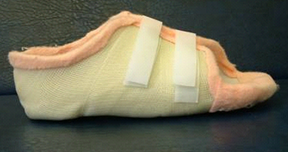- Reference Number: HEY-374/2016
- Departments: Diabetes
- Last Updated: 1 June 2016
Introduction
This leaflet has been produced to give you general information about your treatment. Most of your questions should be answered by this leaflet. It is not intended to replace the discussion between you and your healthcare professional, but may act as a starting point for discussion. If after reading it you have any concerns or require further explanation, please discuss this with a member of the healthcare team caring for you.
What is a slipper cast?
| A slipper cast is a custom-made, slipper shaped device that has a reinforced sole and fits snugly to the foot. It is made from materials similar to those that are used to make casts for broken bones. The flexible sides mean that it can be taken on and off. |  |
Why do I need a slipper cast?
Foot problems can be caused by pressure from everyday activities such as walking and from shoes. Continuing pressure can delay healing of any foot problems therefore slipper casts have been designed to take pressure away from the affected parts of the foot. They are used to divert the pressure away from foot ulcerations, broken bones and in treating the Diabetic Charcot Foot.
Can there be any complications or risks?
Although the cast is custom-made to fit your foot there is a possibility that it could rub. It is important to check the foot and cast regularly and to make sure there is no rubbing.
If the cast does rub stop you must stop using it immediately and contact the Diabetes Foot Protection Team for advice.
How is a slipper cast made?
The cast is made to fit as close to the foot as possible. It is made from layers of casting tape which are wrapped around the foot to create a close fit. Once the cast has set, it is cut and shaped into a slipper. Velcro tapes are used to secure the cast to the foot and allow it to be taken on and off.
How is a slipper cast used?
The cast can be used over normal dressings. The dressings should be as thin as possible to ensure the cast is a snug fit. Your healthcare professional will discuss your dressings with you. The cast must not be put in direct contact with the skin as this may cause rubbing. A thin sock or layer of tubular bandage should be applied first and the Velcro tapes must be fastened firmly to stop the cast moving and rubbing.
A special sandal will be used over the cast as it is too large to fit into ordinary footwear. It is vital that the cast is used whenever walking to keep pressure away from the foot problem. For broken bones or Diabetic Charcot Foot the cast may be used inside a walking brace. The cast should be removed at night and must be kept dry. However the cast should be checked daily and any damage to the device please cease usage and contact the Diabetic Foot Protection Team. The cast can be re-used many times before it needs replacing.
Remember – Seek medical help as soon as possible if you notice any change to the foot such as:
- Rub marks from the cast.
- Swelling.
- Redness.
- Increase in pain.
- Increase in the amount of fluid coming from the ulcer.
- Hot or cold sweats or flu like symptoms.
Should you require further advice on the issues contained in this leaflet, please do not hesitate to contact:
Diabetic Foot Protection Team The Diabetes Centre, Brocklehurst Building.
Telephone number: (01482) 675345. (Mon to Fri 8:30am to 5.00pm.)
General Advice and Consent
Most of your questions should have been answered by this leaflet, but remember that this is only a starting point for discussion with the healthcare team.
Consent to treatment
Before any doctor, nurse or therapist examines or treats you, they must seek your consent or permission. In order to make a decision, you need to have information from health professionals about the treatment or investigation which is being offered to you. You should always ask them more questions if you do not understand or if you want more information.
The information you receive should be about your condition, the alternatives available to you, and whether it carries risks as well as the benefits. What is important is that your consent is genuine or valid. That means:
- you must be able to give your consent
- you must be given enough information to enable you to make a decision
- you must be acting under your own free will and not under the strong influence of another person
Information about you
We collect and use your information to provide you with care and treatment. As part of your care, information about you will be shared between members of a healthcare team, some of whom you may not meet. Your information may also be used to help train staff, to check the quality of our care, to manage and plan the health service, and to help with research. Wherever possible we use anonymous data.
We may pass on relevant information to other health organisations that provide you with care. All information is treated as strictly confidential and is not given to anyone who does not need it. If you have any concerns please ask your doctor, or the person caring for you.
Under the General Data Protection Regulation and the Data Protection Act 2018 we are responsible for maintaining the confidentiality of any information we hold about you. For further information visit the following page: Confidential Information about You.
If you or your carer needs information about your health and wellbeing and about your care and treatment in a different format, such as large print, braille or audio, due to disability, impairment or sensory loss, please advise a member of staff and this can be arranged.

